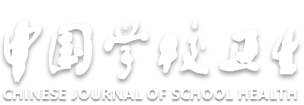Association between polymorphisms in the glucose metabolism and lipid regulation genes with metabolic abnormalities in childhood obesity
-
摘要:
目的 探讨CDKAL1基因rs35261542、FAIM2基因rs3205718及VGLL4基因rs2574704多态性位点与儿童肥胖及合并代谢表型的关联性,为制定儿童肥胖个性化防控措施提供依据。 方法 基于2023年“早期儿童营养包干预长期营养健康作用评估”项目,选取河南(嵩县、汝阳县)、贵州(贵定县、福泉县)4县1 078名5~7岁儿童,按体质量指数Z评分(BMI Z评分)筛选出超重肥胖(OVOB)组儿童87名,按性别、年龄和BMI Z评分匹配体重正常组儿童117名;并按4项传统心脏代谢危险因素(CRs)标准,分为代谢正常体重正常(MHWH,51人)、代谢异常体重正常(MUWH,66人)、代谢正常型肥胖(MHO,31人)和代谢异常型肥胖(MUO,56人)4组。通过问卷调查、体格测量、血清生化检测及KASP基因分型技术,分析基因多态性在不同代谢异质性儿童中的分布,采用多因素Logistic回归模型评估3个基因多态性位点与儿童肥胖及合并代谢表型的关联性。 结果 多因素Logistic回归分析结果显示,CDKAL1 rs35261542纯合突变型AA与OVOB、MHO和MUO的发生风险均呈正相关(OR值分别为3.63,11.04,4.88,P值均 < 0.05);FAIM2 rs3205718纯合突变型TT与OVOB发生风险呈正相关(OR=4.44,P < 0.05),但与代谢表型关联无统计学意义(P值均>0.05);VGLL4 rs2574704纯合突变型TT降低MHO和MUO发生风险(OR值分别为0.30,0.24,P值均 < 0.05)。基因型累积效应分析显示,rs35261542+rs3205718组合携带1个和2个风险基因型者OVOB发生风险增加(OR值分别为2.53,20.79);rs35261542+rs2574704组合MHO和MUO发生风险均增加(OR值分别为8.50,5.00)(P值均 < 0.05)。 结论 rs35261542位点AA型与儿童肥胖及合并代谢异常呈正相关,rs3205718位点TT型与儿童肥胖呈正相关,rs2574704位点TT型与代谢表型呈负相关,且多态性位点风险基因型的数量具有累积效应。 Abstract:Objective To explore the association between CDKAL1 rs35261542, FAIM2 rs3205718, and VGLL4 rs2574704 polymorphisms with childhood obesity and related metabolic phenotypes to provide evidence for personalized prevention and management strategies. Methods Based on the 2023 Long-term Nutritional Health Effects of Early Childhood Nutrition Package Intervention project, the study enrolled 1 078 children aged 5-7 years from four counties in Henan (Songxian and Ruyang countries) and Guizhou (Guiding and Fuquan countries) provinces. Using BMI Z-scores, 87 overweight and obese(OVOB) children were selected and matched by sex, age, and BMI Z-score with 117 normal-weight controls. Participants were further stratified into four metabolic phenotype groups: metabolically healthy normal weight (MHNW, n=51), metabolically unhealthy normal weight (MUNW, n=66), metabolically healthy obesity (MHO, n=31) and metabolically unhealthy obesity (MUO, n=56) based on four conventional cardiometabolic risk factor (CR) criteria. Data were collected through questionnaires, anthropometric measurements, serum biochemical tests, and KASP genotyping. The distribution of three genetic polymorphisms (CDKAL1 rs35261542, FAIM2 rs3205718, VGLL4 rs2574704) across metabolic subgroups was analyzed. Multivariate Logistic regression models assessed associations between these polymorphisms and obesity/metabolic phenotypes. Results Multivariate Logistic regression analysis showed that Homozygous mutant AA genotype of CDKAL1 rs35261542 was positively associated with OVOB(OR=3.63), MHO (OR=11.04), MUO (OR=4.88) (P < 0.05). Homozygous TT genotype of FAIM2 rs3205718 increased OVOB risk (OR=4.44, P < 0.05) but showed no association with metabolic phenotypes (P>0.05). Homozygous mutant TT of VGLL4 rs2574704 reduced the risks of MHO and MUO (OR=0.30, 0.24, P < 0.05). Cumulative genetic effects analysis demonstrated carriers of 1 or 2 risk genotypes of rs35261542 and rs3205718 had progressively higher OVOB risk (OR=2.53, 20.79), and the combination of rs35261542 and rs2574704 increased risks for both MHO (OR=8.50) and MUO (OR=5.00) (P < 0.05). Conclusions The AA genotype of rs35261542 (CDKAL1) positively correlates with childhood obesity and metabolic abnormalities. The TT genotype of rs3205718 (FAIM2) increases obesity risk but not metabolic phenotypes. The TT genotype of rs2574704 (VGLL4) shows protective effects against metabolic dysfunction. Risk genotypes exhibit dose-dependent cumulative effects on obesity and metabolic outcomes. -
Key words:
- Child /
- Obesity /
- Genes /
- Metabolic diseases /
- Regression analysis
1) 利益冲突声明 所有作者声明无利益冲突。 -
表 1 不同组别儿童生化指标比较(x±s)
Table 1. Comparison of biochemical indicators in children of different groups(x±s)
组别 代谢类型 人数 TCHO/
(mmol·L-1)TG/
(mmol·L-1)HDL-C/
(mmol·L-1)LDL-C/
(mmol·L-1)FBG/
(mmol·L-1)ADP/
(μg·mL-1)ALT/
(U·IL-1)AST/
(U·L-1)CRP-H/
(mg·L-1)NOR MHWH 51 4.26±0.68 0.97±0.30 1.65±0.28 1.64±0.39 5.06±0.82 16.06±5.35 10.18±3.73 27.85±5.84 0.75±1.27 MUWH 66 4.22±0.80 1.10±0.47 1.51±0.57 1.51±0.54 5.58±1.72 13.93±5.70 10.19±3.59 26.67±4.80 0.92±1.85 小计 117 4.24±0.75 1.04±0.41 1.57±0.47 1.57±0.48 5.35±1.42 14.86±5.63 10.19±3.63 27.19±5.29 0.84±1.62 OVOB MHO 31 4.43±0.47 1.04±0.34 1.62±0.27 1.80±0.37 4.99±0.99 12.46±5.49 11.71±4.59 26.26±4.97 3.15±7.28 MUO 56 4.33±0.68 1.75±1.19 1.45±0.40 1.67±0.51 5.71±1.28 14.14±6.64 14.13±11.66 29.61±13.52 1.78±2.99 小计 87 4.36±0.61 1.50±1.03 1.51±0.37 1.71±0.47 5.45±1.23 13.54±6.28 13.27±9.78 28.41±11.32 2.27±4.97 合计 204 4.29±0.69 1.24±0.77 1.54±0.43 1.63±0.48 5.39±1.34 14.30±5.94 11.51±7.11 27.72±8.42 1.45±3.53 F值 0.71 13.90 2.53 2.96 3.62 2.97 4.07 1.60 3.88 P值 0.55 < 0.01 0.06 0.03 0.01 0.03 0.01 0.19 0.01 注: F值为4组代谢类型间比较。 表 2 不同体重合并代谢表型儿童rs35261542、rs3205718和rs2574704位点分布特征
Table 2. Distribution characteristics of rs35261542, rs3205718 and rs2574704 loci in different weights children with metabolic heterogeneity
单核苷酸多态性基因 基因型 NOR OVOB 合计(n=204) MHWH(n=51) MUWH(n=66) 小计(n=117) MHO(n=31) MUO(n=56) 小计(n=87) rs35261542 AA 4(7.8) 7(10.6) 11(9.4) 7(22.6) 14(25.0) 21(24.1) 32(15.7) CA 23(45.1) 39(59.1) 62(53.0) 18(58.1) 22(39.3) 40(46.0) 102(50.0) CC 24(47.1) 20(30.3) 44(37.6) 6(19.4) 20(35.7) 26(29.9) 70(34.3) rs3205718 CC 33(64.7) 35(53.0) 68(58.1) 14(45.2) 32(57.1) 46(52.9) 114(55.9) CT 16(31.4) 29(43.9) 45(38.5) 12(38.7) 16(28.6) 28(32.2) 73(35.8) TT 2(3.9) 2(3.0) 4(3.4) 5(16.1) 8(14.3) 13(14.9) 17(8.3) rs2574704 CC 9(17.6) 29(43.9) 38(32.5) 14(45.2) 20(35.7) 34(39.1) 72(35.3) CT 36(70.6) 31(41.0) 67(57.3) 14(45.2) 26(46.4) 40(46.0) 107(52.5) TT 6(11.8) 6(9.1) 12(10.3) 3(9.7) 10(17.9) 13(14.9) 25(12.3) 注: ()内数字为构成比/%。 表 3 基因多态性位点rs35261542、rs3205718和rs2574704与肥胖儿童合并代谢表型关联性分析(n=204)
Table 3. Association analysis of gene polymorphism loci rs35261542, rs3205718 and rs2574704 with metabolic heterogeneity in obese children(n=204)
自变量 基因型 OVOB MHO MUO OR值(95%CI) P值 OR值(95%CI) P值 OR值(95%CI) P值 rs35261542 AA 3.63(1.34~9.84) 0.01 11.04(2.07~58.91) 0.01 4.88(1.23~19.37) 0.02 CA 1.23(0.59~2.54) 0.58 4.66(1.35~16.16) 0.02 1.33(0.51~3.44) 0.56 CC 1.00 1.00 1.00 显性模型 AA 3.19(1.32~7.73) 0.01 4.01(0.98~16.40) 0.05 4.11(1.15~14.71) 0.03 CA+CC 1.00 1.00 1.00 隐性模型 AA+CA 0.63(0.32~1.26) 0.19 5.57(1.68~18.53) 0.01 1.86(0.76~4.52) 0.17 CC 1.00 1.00 1.00 rs3205718 TT 4.44(1.23~16.06) 0.02 5.35(0.82~34.92) 0.08 3.44(0.59~20.11) 0.17 CT 0.97(0.49~1.91) 0.92 1.92(0.67~5.49) 0.23 1.13(0.45~2.83) 0.80 CC 1.00 1.00 1.00 隐性模型 CC+CT 1.00 1.00 1.00 TT 4.50(1.28~15.87) 0.02 4.14(0.67~25.61) 0.13 3.30(0.58~18.69) 0.18 rs2574704 CC 1.00 1.00 1.00 TC 0.71(0.24~2.10) 0.54 0.33(0.06~1.97) 0.22 0.47(0.11~2.06) 0.32 TT 0.57(0.29~1.15) 0.12 0.30(0.10~0.94) 0.04 0.24(0.09~0.67) 0.01 显性模型 CC 1.00 1.00 1.00 TC+TT 1.69(0.86~3.32) 0.13 0.30(0.10~0.91) 0.03 0.27(0.10~0.73) 0.01 注:校正性别、年龄、出生体重、是否母乳喂养、母乳喂养时间和CRP-H、ALT、ADP等协变量;因变量体重分组以NOR为参照,代谢异常表型分组以MHWH为参照。 -
[1] DROZDZ D, ALVAREZ-PITTI J, WÓJCIK M, et al. Obesity and cardiometabolic risk factors: from childhood to adulthood[J]. Nutrients, 2021, 13(11): 4176. doi: 10.3390/nu13114176 [2] PAN X F, FANG Z Z. Obesity in China: what we know and what we can do[J]. Lancet Public Health, 2024, 9(12): e1000-e1001. doi: 10.1016/S2468-2667(24)00271-8 [3] SUN X, YAN A F, SHI Z, et al. Health consequences of obesity and projected future obesity health burden in China[J]. Obesity(Silver Spring), 2022, 30(9): 1724-1751. [4] LIU Z, GAO P, GAO A Y, et al. Effectiveness of a multifaceted intervention for prevention of obesity in primary school children in China: a cluster randomized clinical trial[J]. JAMA Pediatr, 2022, 176(1): e214375. doi: 10.1001/jamapediatrics.2021.4375 [5] WANG F, ZHENG J, CHENG J, et al. Personalized nutrition: a review of genotype-based nutritional supplementation[J]. Front Nutr, 2022, 9: 992986. doi: 10.3389/fnut.2022.992986 [6] BONÀS-GUARCH S, GUINDO-MARTÍNEZ M. Publisher correc- tion: re-analysis of public genetic data reveals a rare X-chromosomal variant associated with type 2 diabetes[J]. Nat Commun, 2018, 9(1): 2162. doi: 10.1038/s41467-018-04170-3 [7] JAFARI A, KHOSHDOOZ S, BAFRANI M A, et al. Uncovering the causal link between obesity-associated genes and multiple sclerosis: a systematic literature review[J]. Brain Behav, 2025, 15(4): e70439. doi: 10.1002/brb3.70439 [8] CRAIG S J C, KENNEY A M, LIN J, et al. Constructing a polygenic risk score for childhood obesity using functional data analysis[J]. Econom Stat, 2023, 25: 66-86. [9] ZHOU P, KESSINGER C W, GU F, et al. Vestigial like 4 regulates the adipogenesis of classical brown adipose tissue[J]. BioRxiv[Preprint], 2024. DOI: 10.1101/2024.07.09.602788. [10] DE ONIS M, ONYANGO A W, BORGHI E, et al. Development of a WHO growth reference for school-aged children and adolescents[J]. Bull World Health Organ, 2007, 85(9): 660-667. doi: 10.2471/BLT.07.043497 [11] NASREDDINE L, TAMIM H, MAILHAC A, et al. Prevalence and predictors of metabolically healthy obesity in adolescents: findings from the national "Jeeluna" study in Saudi-Arabia[J]. BMC Pediatr, 2018, 18(1): 281. doi: 10.1186/s12887-018-1247-z [12] 中华人民共和国国家卫生和计划生育委员会. 人群健康监测人体测量方法: WS/T 424—2013[S]. 北京: 中国标准出版社, 2013.National Health and Family Planning Commission of the PRC. Anthropometric measurements method in health surveillance: WS/T 424-2013[S]. Beijing: Standards Press of China, 2013. (in Chinese) [13] LISTER N B, BAUR L A. Child and adolescent obesity[J]. Nat Rev Dis Primers, 2023, 9(1): 24. doi: 10.1038/s41572-023-00435-4 [14] SILVENTOINEN K, JELENKOVIC A, SUND R, et al. Genetic and environmental effects on body mass index from infancy to the onset of adulthood: an individual-based pooled analysis of 45 twin cohorts participating in the Collaborative Project of Development of Anthropometrical Measures in Twins (CODATwins) study[J]. Am J Clin Nutr, 2016, 104(2): 371-379. doi: 10.3945/ajcn.116.130252 [15] COUTO ALVES A, DE SILVA N M G, KARHUNEN V, et al. GWAS on longitudinal growth traits reveals different genetic factors influencing infant, child, and adult BMI[J]. Sci Adv, 2019, 5(9): eaaw3095. doi: 10.1126/sciadv.aaw3095 [16] TAM C H, WANG Y, WANG C C, et al. Identification and potential clinical utility of common genetic variants in gestational diabetes among Chinese pregnant women[J]. Diabetes Metab J, 2025, 49(1): 128-143. doi: 10.4093/dmj.2024.0139 [17] LIM E B, CHO Y S. Identification of genetic loci enriched in obese or lean T2D cases in the Korean population[J]. Genes Genomics, 2025, 47(2): 235-243. doi: 10.1007/s13258-024-01602-x [18] MORITA S, SHIMAJIRI Y, MATSUOKA Y, et al. Exploring genetic risk factors for β-cell deterioration in type 2 diabetes mellitus: insights from longitudinal C-peptide analysis[J]. Diabetes Res Clin Pract, 2025, 222: 112049. doi: 10.1016/j.diabres.2025.112049 [19] ABIRI B, VALIZADEH M, AMINI S, et al. Risk factors, cutoff points, and definition of metabolically healthy/unhealthy obesity in children and adolescents: a scoping review of the literature. Obesity reviews: an official journal of the international association for the study of obesity[J]. Obes Rev, 2023, 24(5): e13548. doi: 10.1111/obr.13548 [20] VUKOVIC R, DOS SANTOS TJ, YBARRA M, et al. Children with metabolically healthy obesity: a review[J]. Front Endocrinol (Lausanne), 2019, 10: 865. doi: 10.3389/fendo.2019.00865 [21] SUMIńSKA M, PODGÓRSKI R, FICHNA P, et al. Steroid metabolism in children and adolescents with obesity and insulin resistance: altered SRD5A and 20α/20βHSD activity[J]. Front Endocrinol (Lausanne), 2021(12): 759971. [22] SUMIńSKA M, PODGÓRSKI R. The impact of obesity on the excretion of steroid metabolites in boys and girls: a comparison with normal-weight children[J]. Nutrients, 2023, 15(7): 1734. doi: 10.3390/nu15071734 [23] GAWLIK A, SHMOISH M, HARTMANN M F, et al. Steroid metabolomic disease signature of nonsyndromic childhood obesity[J]. Endocr Connect, 2019, 8(6): 764-771. doi: 10.1530/EC-18-0536 [24] GHOSH C, DAS N, SAHA S, et al. Involvement of Cdkal1 in the etiology of type 2 diabetes mellitus and microvascular diabetic complications: a review[J]. J Diabetes Metab Disord, 2022, 21(1): 991-1001. doi: 10.1007/s40200-021-00953-6 [25] BRADFIELD J P, VOGELEZANG S, FELIX J F, et al. A trans-ancestral Meta-analysis of genome-wide association studies reveals loci associated with childhood obesity[J]. Hum Mol Genet, 2019, 28(19): 3327-3338. doi: 10.1093/hmg/ddz161 [26] ZHANG W, XU J, LI J, et al. The TEA domain family transcription factor TEAD4 represses murine adipogenesis by recruiting the cofactors VGLL4 and CtBP2 into a transcriptional complex[J]. J Biol Chem, 2018, 293(44): 17119-17134. doi: 10.1074/jbc.RA118.003608 [27] 夏志伟, 宫照龙, 孙静, 等. 生命早期因素对肠道菌群与儿童肥胖的影响及干预研究进展[J]. 中国学校卫生, 2024, 45(11): 1657-1662. doi: 10.16835/j.cnki.1000-9817.2024314XIA Z W, GONG Z L, SUN J, et al. Research progress on the impact and intervention of early life factors on gut microbiota and childhood obesity[J]. Chin J Sch Health, 2024, 45(11): 1657-1662. (in Chinese) doi: 10.16835/j.cnki.1000-9817.2024314 [28] 夏志伟, 沈葹, 王路, 等. 转录组学蛋白组学和代谢组学生物标志物与儿童肥胖研究进展[J]. 中国学校卫生, 2024, 45(9): 1364-1368. doi: 10.16835/j.cnki.1000-9817.2024281XIA Z W, SHENG S, WANG L, et al. Advances in transcriptomic, proteomic and metabolomic biomarkers and childhood obesity[J]. Chin J Sch Health, 2024, 45(9): 1364-1368. (in Chinese) doi: 10.16835/j.cnki.1000-9817.2024281 -

 点击查看大图
点击查看大图
计量
- 文章访问数: 14
- HTML全文浏览量: 8
- PDF下载量: 3
- 被引次数: 0





 下载:
下载: